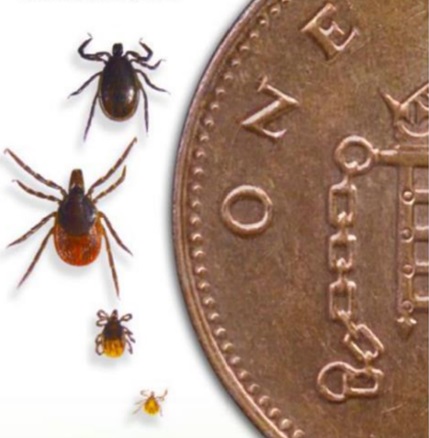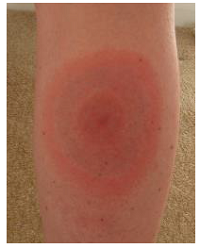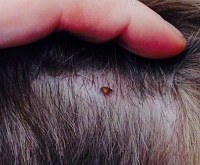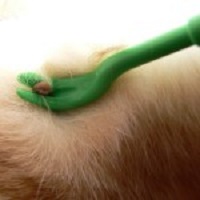What is a tick
Ticks are small spider-like parasites. They feed on the blood of birds and mammals, including humans.
They have 8 legs and an egg-shaped body which will become larger and darker when filled with blood. Ticks vary in size and are usually between 1mm to 1cm long.
Ticks don’t fly or jump. They climb on to humans and animals when they brush past.
You’re more likely to find ticks in woodland and grassland, especially in areas with a lot of:
- trees that lose their leaves
- undergrowth or bushes
You'll most likely see them between March and October but they’re active all year. Tick season can be longer if the weather is wet and temperatures warmer.
Tick bites can carry diseases, so it's important to remove them straight away.
Symptoms of tick bites
Tick bites don’t usually hurt but they can cause a red lump to develop where you were bitten.
In some cases, tick bites can cause:
- swelling
- itchiness
- blistering
- bruising
Tick sizes compared to a one penny coin

Lyme disease
Lyme disease is a bacterial infection that can be spread to humans by infected ticks.
A small number of ticks carry the bacteria that can cause Lyme disease so being bitten doesn’t mean you’ll be infected.
Lyme disease can be treated if it’s diagnosed early. You should speak to a GP if you start to feel unwell and have symptoms.
Lyme disease on the NHS
Lyme disease symptoms
Early symptoms of Lyme disease usually develop 1 to 4 weeks after being bitten but they can appear anytime between 3 to 30 days after exposure.
The most common signs of Lyme disease are:
- a circular bullseye or oval shape rash around a tick bite
- fever
- headache
- flu like symptoms
- feeling tired
The early stages of Lyme disease can be treated with antibiotics. Early treatment prevents later symptoms of the disease developing.
If you leave Lyme disease untreated you can develop more serious symptoms several weeks, months or even years later. These can include:
- pain and swelling in the joints
- numbness and pain in your limbs, paralysis of your facial muscles, memory problems and difficulty concentrating
- severe headaches, a stiff neck and increased sensitivity to light
In Jersey, the risks of catching Lyme disease from a tick bite are very low. There's only been 2 cases on the Island since 2015.
Lyme disease: signs and symptoms on GOV.UK
Lyme disease bullseye rash

How to remove ticks
Most ticks don't carry the bacteria that causes Lyme disease, but you should try to remove it as soon as possible. This will reduce the risk of you getting it.
You should do body checks on you and your pet after a walk.
If you’ve been bitten by a tick, it will attach to your skin. You should:
- use a tick removal tool or fine-toothed tweezers to gently grip the tick as close to the skin as possible
- pull steadily away from the skin without crushing the tick
- wash your skin with water and soap afterwards
- apply an antiseptic cream to the skin around the bite
You can find tick removal tools in many pharmacies or at your vet.
Never remove a tick by pulling, crushing, or squeezing it.
After you removed a tick, monitor the area where you were bitten. You do not need to speak to your GP unless you start to feel unwell and have symptoms.
How to remove a tick by NHS 24 on YouTube
Tick found under hair

Ticks on dogs and cats
Dogs and cats can become ill from Anaplasmosis. This disease is caused by the bacteria Anaplasma which is carried by ticks.
Some cases of Anaplasmosis have been found in Jersey but are low.
Symptoms of the disease in your pet include:
- depression
- loss of appetite
- fever
- lameness
- swollen and painful joints
- swollen lymph nodes
- lethargy
Contact your vet if you’re worried about your pet or need advice.
Find more guidance about
ticks on dogs and cats on RSPCA.
Tick removal from a pet

Be tick aware
You can prevent tick bites in many ways:
- walk on clearly defined paths to avoid brushing against plants
- wear a long-sleeved tops and long trousers tucked into socks
- wear closed footwear such as boots
- check your clothes. Try to wear light coloured clothing, as ticks will be easier to spot
- use insect repellents containing DEET (diethyltoluamide)
- if you spend time outside, check yourself regularly especially behind your knees, groin, waist, armpits and hairline
- check children's heads and neck areas, including the scalp
- ticks can be very small, look for something as tiny as a freckle or a speck of dirt, especially in skin folds
- take check children's heads and neck areas, including the scalp
- a shower or bath
- check pets for ticks and speak to your vet about tick control
Ticks can be very small. Look for something as tiny as a freckle or a speck of dirt, especially in skin folds.
You should also learn how to remove ticks safely from you or your pet and use a tick removal tool.
 Enjoy the outdoors but be tick aware poster
Enjoy the outdoors but be tick aware poster
Tick awareness and toolkit on GOV.UK